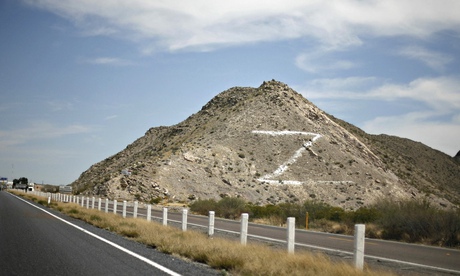As the US softens its stance on drugs at home, David Huey reviews the effects of its tactics to dismantle cartels in Latin America and the implications for policymakers

The letter "Z", referring to the Zetas drug cartel, is seen painted on a hill at the road between Monterrey and Torreon, in the Mexican state of Coahuila. Photograph: Tomas Bravo/Reuters
The legacy of the US-funded war on drugs in Latin America is profound even as its impact has been temporary and geographically limited. Since the 1970s, the US has spent more than a trillion dollars attempting to dismantle drug cartels in Latin America. Yet, US-funded aerial fumigation programmes and anti-narcotics policing in the southern Andes, for example, only succeeded in pushing the problem north, further destabilising the armed conflict in Colombia.
During the 1980s, Peru, Bolivia and Colombia were responsible for 65%, 25% and 10% of the world's coca production respectively. By 2000, however, the US "war on drugs" in neighbouring Andean countries had turned Colombia into the world's largest cocaine producer by far, representing 90% of the total.
The 20-year war to dismantle the Colombian cartels has cost approximately 15,000 lives, many of them innocent victims of narco-terrorism. A few years after the demise of the big cartels, paramilitaries and the Farc guerrilla movement massacred or displaced millions of small farmers in their struggle to control land and drug-trafficking routes.
Between 2000 and 2010, the US spent $7.3bn on a military and economic aid programme called Plan Colombia. Although it was successful at bringing many coca-growing areas under state control and substantially reducing drug-related violence, Colombia remains a major coca and cocaine producing country. Today, the Farc are on the retreat and the big cartels have long gone, but the lucrative trade has been taken over by a network of mini-cartels and demobilised paramilitaries. Plan Colombia also displaced the drug trade back into Peru and Bolivia, as well as north into Central America and Mexico.
Supported by the US-financed Mérida Initiative, in 2006 the Mexican government declared a war on the drug cartels that has killed or led to the disappearance of 100,000 Mexicans so far; 90% of the cocaine that enters the US passes through Mexico, a trade that is now valued at between $19bn and $29bn.
Meanwhile, the proportion of people consuming illicit drugs in the US has not changed significantly since the war on drugs began. Although the extent of drug abuse has remained stable overall, drug consumption has switched from harder, more socially destructive drugs like cocaine and methamphetamine (both have fallen approximately 40% in recent years), to softer drugs like marijuana. The US now spends $8bn a year on fighting pot and half of all arrests are related to the drug, even though many experts believe it is less harmful than alcohol and may even offer benefits to people suffering from serious illnesses like cancer.
These new realities are putting drug policy reform on the agenda for the first time at the Organisation of American States (pdf). Uruguay has become the first Latin American country to legalise marijuana. It has also joined Bolivia in implementing national policies that emphasise the human rights of victims of the drug trade, who are mainly poor coca producers and drug users. Guatemala and Colombia have loudly backed change despite obstacles to implementing reform at home.
Even the US is showing signs of softening its stance on drugs. The states of Colorado and Washington recently legalised marijuana, a move now supported by 55% of Americans. Drug reformers nationwide continue to argue that legalisation will free up resources needed to fight harder drugs, deny traffickers billions of dollars in profits, and generate tax revenues for prevention and treatment through state-controlled marijuana sales. There has also been small but significant reforms to drug-related health and justice policies at the federal level.
Despite these changes, most Latin American countries remain firmly opposed to the liberalisation of drug laws. Only time will tell if the limited reforms in countries such as Uruguay and Bolivia will become the threat of the good example for the rest of the region. But the debate in Latin America is at least broadening at the same time as US influence over drug policies in the region is clearly on the wane.
What is becoming clear is that a new approach is needed as Latin American countries debate alternatives to the US war on drugs. Eric Olson, associate director of the Woodrow Wilson Center, commented: "A US policy that acknowledges its shared responsibility in the region's drug problems, and seeks collaborative solutions is an important first step. Declining US aid, a weakened drug certification process, and the willingness of some countries, especially Bolivia, to resist US pressure suggests that the US cannot continue to dictate the implementation of policy as it did in the 70s and 80s."
David Huey is currently working as an independent consultant0 in Colombia, but before that was the country director for Oxfam from 2007 to 2012.


Nenhum comentário:
Postar um comentário